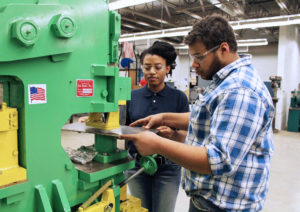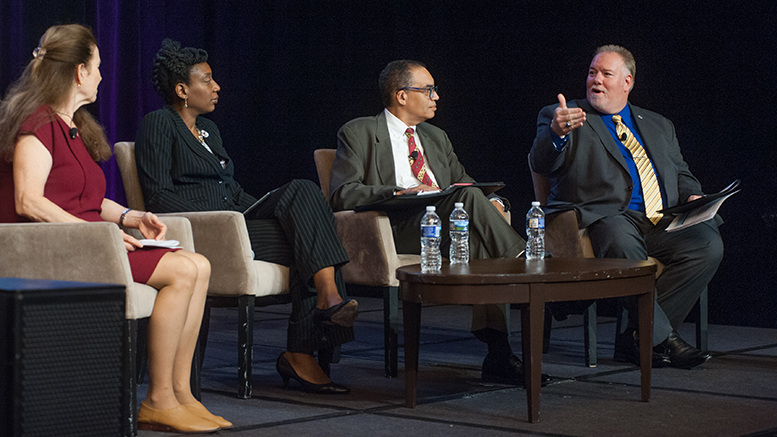First the good news: Connecticut offers proof that it is possible to improve attitudes about manufacturing careers and increase enrollments in advanced technology programs.
Still, there are challenges in Connecticut and elsewhere: Technology continues to change the nature of work, requiring more “nimble” technicians at a time when many people aspire for careers that offer more flexibility than the typical 40-hour work week. And throughout the nation, race and gender disparities persist in the STEM workforce and education programs.
A hopeful sign: The National Science Board (NSB) is focusing attention on the skilled technical workforce, which it defines as “people who use STEM skills in the workplace, but who do not have a four-year degree.” It held two “listening sessions” on October 26 at Baton Rouge Community College and Xavier University. The NSB governs the National Science Foundation (NSF) and advises Congress and the president on science policies.
During a panel discussion last week at the 2017 Advanced Technological Education (ATE) Principal Investigators Conference in Washington, D.C., NSB Member Victor R. McCrary said he hopes that the listening sessions will be followed by a formal NSB task force that will support ATE and similar programs.
ATE provides grants to innovative technician education programs in fields that are important to the nation’s security. With two-year college educators having leadership roles in these funded initiatives, the ATE program is NSF’s largest investment in associate degree-granting institutions.
Connecticut’s systematic approach
To attract and retain students in its technical programs, Connecticut has since 2012 invested millions of dollars in seven advanced manufacturing facilities at two-year college campuses. With support from the ATE program, the Regional Center for Next Generation Manufacturing (RCNGM) based at the Connecticut College of Technology offers professional development for faculty, curriculum and career pathways, STEM career awareness programs, and collaborations with employers.
Since 2004, there has been a sizeable increase in the number of associate degrees awarded by the College of Technology, which is the umbrella organization for technical programs across Connecticut. The number of women and underrepresented minorities among graduates also has increased.
“Connecticut really has been focused on developing a skilled workforce,” said James Lombella, president of Asnuntuck Community College.

In June, Asnuntuck Community College opened a 27,000-square-foot addition to its 50,000-square-foot Advanced Manufacturing Technology Center. (Photo: Asnuntuck)
At the grassroots level, he said, Asnuntuck has found it is cost effective to provide free childcare and free bus passes to help students stay enrolled and complete certificates and associate degrees.
Lombella pointed out that public perceptions about manufacturing have improved over the past nine years with the state’s widely publicized “We Make It Here”” coordinated advanced manufacturing career pathways. Marketing is necessary to sustain enrollments in expensive technology programs, he said.
“You have to spend money to make money,” said Lombella, explaining that tuition from new students covers advertising costs. “If we can’t run a $50,000 marketing campaign and enroll 10 new students we are doing something gravely wrong.”
The changing nature of work
As a research professor and chief economist at the Georgetown University Center on Education and the Workforce, Nicole Smith offered a national perspective and noted that contingent work appeals to many young people who want more flexibility than 9 to 5 or other shift-based employment.

Nicole Smith explains that employees seek more flexibility in their jobs. (Photo: James Tkatch)
“Because of changing nature of work, we have to look at different types of incentives to get people to work longer hours, separate and apart from money,” she said.
While aversion to student loan debt is understandable, she said, “the only thing more expensive than going to college is not going to college.”
She urged the educators in her audience to create the conditions to help people complete credentials in majors that lead to careers that support families. All ATE-affiliated programs prepare students for careers in STEM fields with higher than average wages; and ATE principal investigators report that their graduates readily find employment. Many ATE projects and centers also collaborate with industry partners to facilitate paid internships, which Smith said are more important than low-skill jobs that students often use to cover college costs.
Informing counselors and parents
The panelists also addressed the need to persuade guidance counselors to include certificate, associate degrees and apprenticeships in discussions with high school student about postsecondary options.
“You’ve got to get the high school counselors de-coupled from the single-path mentality for students — that a college education is the only way to the American dream,” said McCrary, who also is vice president for research and economic development at Morgan State University.
All the panelists agreed that parents, too, need help understanding that four-year degrees are not the only path to fulfilling careers.
Publications mentioned during the discussion and recommended by the panelists for two-year college educators and their industry partners include:
- “Building America’s Skilled Technical Workforce”
- “Good Jobs that Pay Without the BA”
- “Career Pathways: Five Ways to Connect College and Careers”
- “The Hidden STEM Economy”

